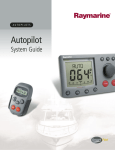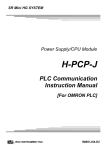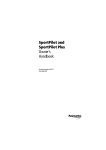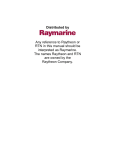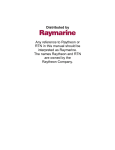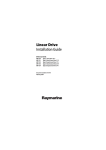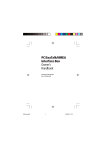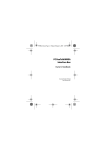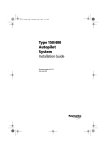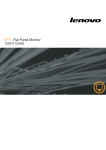Download Raymarine Rudder Installation guide
Transcript
Distributed by Any reference to Raytheon or RTN in this manual should be interpreted as Raymarine. The names Raytheon and RTN are owned by the Raytheon Company. 81006_3.book Page 1 Tuesday, May 22, 2001 1:03 PM Linear Rudder Position Sensor Installation Guide Document number: 81006-3 Date: May 2001 81006_3.book Page 2 Tuesday, May 22, 2001 1:03 PM 2 Linear Rudder Position Sensor Important information Safety notices WARNING: Product installation This equipment must be installed and operated in accordance with the instructions contained in this handbook. Failure to do so could result in poor product performance, personal injury and/or damage to your boat. Because correct performance of the boat’s steering is critical for safety, we STRONGLY RECOMMEND that an Authorized Raymarine Service Representative fits this product. WARNING: Navigation aid Although we have designed this product to be accurate and reliable, many factors can affect its performance. As a result, it should only be used as an aid to navigation and should never replace commonsense and navigational judgement. Always maintain a permanent watch so you can respond to situations as they develop. EMC conformance All Raymarine equipment and accessories are designed to the best industry standards for use in the recreational marine environment. The design and manufacture of Raymarine equipment and accessories conform to the appropriate Electromagnetic Compatibility (EMC) standards, but correct installation is required to ensure that performance is not compromised. Handbook information To the best of our knowledge, the information in this handbook was correct when it went to press. However, Raymarine cannot accept liability for any inaccuracies or omissions it may contain. In addition, our policy of continuous product improvement may change specifications without notice. As a result, Raymarine cannot accept liability for any differences between the product and the handbook. © Raymarine Ltd 2001. 81006_3.book Page 3 Tuesday, May 22, 2001 1:03 PM Installation Guide 3 Introduction Product description The linear rudder position sensor (part number: M81188) is designed for ‘bullhorn’ style hydraulic outboard steering systems. It is totally weatherproof and designed to be mounted on the bullhorn ram. It transmits the precise position of the boat’s rudder to the autopilot. 425 mm (16.75 in) 32 mm (1.3 in) D5389-1 Linear rudder position sensor - dimensions Parts supplied The linear rudder position sensor package contains: • • • • • • • this installation guide linear rudder position sensor spacers (x2) 80 mm (3.1 in) hose clamps (x2) U-bracket M8 nut and washer female spade connectors (x4) 81006_3.book Page 4 Tuesday, May 22, 2001 1:03 PM 4 Linear Rudder Position Sensor Mounting Starboard bolt Nut and washer End bracket Bullhorn ram shaft Threaded rod U-bracket Sensor shaft Sensor shaft Sensor barrel Alignment mark Sensor barrel Cable Hose clamp Spacer Bullhorn ram D5390-1 1. Use the steering system to position the bullhorn ram amidships. 2. If necessary, release the hydraulic pressure from the boat’s hydraulic steering system Note: Contact your steering gear manufacture for advice on this step, and follow their instructions for releasing the hydraulic pressure. 3. Loosen the starboard bolt that secures the bullhorn ram’s shaft to the end bracket. 4. Fit the U-bracket (supplied) over the end bracket and the bullhorn ram’s shaft. 5. Hand tighten the starboard bolt to hold the U-bracket in place. 6. Fully open the hose clamps (supplied) using a flat bladed screwdriver, then hang them over the bullhorn ram. 7. Place the spacers (supplied) on the bullhorn ram and use adhesive tape to secure them temporarily. 8. Pull out the rudder sensor’s shaft until its alignment mark is level with the end of the barrel. 9. Position the rudder sensor against the spacers so the threaded rod end of its shaft passes through the U-bracket. 81006_3.book Page 5 Tuesday, May 22, 2001 1:03 PM Installation Guide 5 10. Tighten the hose clamps around the bullhorn ram and the rudder sensor’s barrel. 11. Tighten the starboard bullhorn bolt to secure the U-bracket. 12. Fit and tighten the supplied nut and washer to secure the threaded rod end of the sensor’s shaft to the U-bracket. Notes: 1. If there is restricted space below the ram, you can mount the sensor in front of the ram (not below it). 2. We recommend installing the sensor with its shaft pointing to starboard. If you cannot install the unit in this orientation, you can fit it with the shaft pointing to port. If you do this, swap the red and green connections at the course computer. Connecting to the course computer 1. Route the cable to the autopilot or course computer, taking into account the EMC installation guidelines. 2. Connect to the RUDDER terminals on the autopilot or course computer, as described in the owner’s handbook. If required, fit the spade connectors provided. Note: To allow for the bullhorn’s movement, leave a loop of cable at the end of the linear rudder position sensor. If the standard cable is not long enough, your Raymarine dealer can supply a 10 m (30 ft) extension cable (part number: D173). Post installation checks When you have connected the sensor to your autopilot, pressurize the steering system (if required). Note: Contact your steering gear manufacture for advice on this step. Follow their instructions for re-pressurizing the hydraulic pressure. When you have done this, check the sensor’s operation as described in the autopilot owner’s handbook. 81006_3.book Page 6 Tuesday, May 22, 2001 1:03 PM 6 Linear Rudder Position Sensor Raymarine EMC Guidelines EMC Installation & Service Guidelines IMPORTANT NOTE All Raymarine equipment and accessories are designed to the best industry standards for use in the leisure marine environment. When powered up, all electrical equipment produces electromagnetic fields. These can cause adjacent pieces of electrical equipment to interact with one another, with a consequent adverse effect on operation. In order to minimise these effects and enable you to get the best possible performance from your Raymarine equipment, these guidelines are provided to enable you to ensure minimum interaction between different items of equipment, i.e. ensure optimum Electromagnetic Compatibility (EMC). The design and manufacture of Raymarine equipment and accessories conform to the appropriate EMC standards, but correct installation is required to ensure that performance is not compromised. Although every effort has been taken to ensure that they will perform under all conditions, it is important to understand what factors could affect the operation of the product. Please keep this document for future reference. Safety Some products generate high voltages, so never handle the cables/connectors when power is being supplied to the equipment. Installation These guidelines describe the conditions for optimum EMC performance, but it is recognised that it may not be possible to meet all of these conditions in all situations. To ensure the best possible conditions for EMC performance within the constraints imposed by any location, always ensure the maximum separation possible between different items of electrical equipment. For optimum EMC performance, it is recommended that wherever possible: • Raymarine equipment and cables connected to it are: • At least 1 m (3 ft) from any equipment transmitting or cables carrying radio signals e.g. VHF radios, cables and antennas. In the case of SSB radios, the distance should be increased to 2 m (7 ft). • More than 2 m (7 ft) from the path of a radar beam. A radar beam can normally be assumed to spread 20 degrees above and below the radiating element. • The equipment is supplied from a separate battery from that used for engine start. Voltage drops below 10 V in the power supply to our products, and starter motor transients, can cause the equipment to reset. This will not damage the equipment, but may cause the loss of some information and may change the operating mode. Raymarine EMC Guidelines • • Raymarine specified cables are used at all times. Cutting and rejoining these cables can compromise EMC performance and so must be avoided unless doing so is detailed in the installation manual. If a suppression ferrite is attached to a cable, this ferrite should not be removed. If the ferrite needs to be removed during installation it must be reassembled in the same position. Suppression Ferrites The following illustration shows typical cable suppression ferrites fitted to Raymarine equipment. Always use the ferrites supplied by Raymarine. D3548-2 Connections to Other Equipment If your Raymarine equipment is to be connected to other equipment using a cable not supplied by Raymarine, a suppression ferrite MUST always be fitted to the cable close to the Raymarine unit. Check Before Going to Sea Always check the installation before going to sea to make sure that it is not affected by radio transmissions, engine starting etc. Servicing Raymarine equipment should be serviced only by authorised Raymarine service technicians. They will ensure that service procedures and replacement parts used will not affect performance. There are no user serviceable parts in any Raymarine product. Always report any EMC related problem to your nearest Raymarine dealer. We use such information to improve our quality standards. In some installations it may not be possible to prevent equipment from being affected by external influences. In general this will not damage the equipment but it can lead to spurious resetting action, or momentarily may result in faulty operation. Document number: 84018-5 Date: May 2001 81006_3.book Page 1 Tuesday, May 22, 2001 1:03 PM Limited Warranty Certificate Raymarine warrants each new Light Marine/Dealer Distributor Product to be of good materials and workmanship, and will repair or exchange any parts proven to be defective in material and workmanship under normal use for a period of 2 years/24 months from date of sale to end user, except as provided below. Defects will be corrected by Raymarine or an authorized Raymarine dealer. Raymarine will, except as provided below, accept labor cost for a period of 2 years/24 months from the date of sale to end user. During this period, except for certain products, travel costs (auto mileage and tolls) up to 100 round trip highway miles (160 kilometres) and travel time of 2 hours, will be assumed by Raymarine only on products where proof of installation or commission by authorized service agents, can be shown. Warranty Limitations Raymarine Warranty policy does not apply to equipment which has been subjected to accident, abuse or misuse, shipping damage, alterations, corrosion, incorrect and/or non-authorized service, or equipment on which the serial number has been altered, mutilated or removed. Except where Raymarine or its authorized dealer has performed the installation, it assumes no responsibility for damage incurred during installation. This Warranty does not cover routine system checkouts or alignment/calibration, unless required by replacement of part(s) in the area being aligned. A suitable proof of purchase, showing date, place, and serial number must be made available to Raymarine or authorized service agent at the time of request for Warranty service. Consumable items, (such as: Chart paper, lamps, fuses, batteries, styli, stylus/drive belts, radar mixer crystals/diodes, snap-in impeller carriers, impellers, impeller bearings, and impeller shaft) are specifically excluded from this Warranty. Magnetrons, Cathode Ray Tubes (CRT), TFT Liquid Crystal Displays (LCD) and cold cathode fluorescent lamps (CCFL), hailer horns and transducers are warranted for 1 year/12 months from date of sale. These items must be returned to a Raymarine facility. All costs associated with transducer replacement, other than the cost of the transducer itself, are specifically excluded from this Warranty. Overtime premium labor portion of services outside of normal working hours is not covered by this Warranty. Travel cost allowance on certain products with a suggested retail price below $2500.00 is not authorized. When/or if repairs are necessary, these products must be forwarded to a Raymarine facility or an authorized dealer at owner’s expense will be returned via surface carrier at no cost to the owner. Travel costs other than auto mileage, tolls and two (2) hours travel time, are specifically excluded on all products. Travel costs which are excluded from the coverage of this Warranty include but are not limited to: taxi, launch fees, aircraft rental, subsistence, customs, shipping and communication charges etc. Travel costs, mileage and time, in excess to that allowed must have prior approval in writing. TO THE EXTENT CONSISTENT WITH STATE AND FEDERAL LAW: (1) THIS WARRANTY IS STRICTLY LIMITED TO THE TERMS INDICATED HEREIN, AND NO OTHER WARRANTIES OR REMEDIES SHALL BE BINDING ON RAYMARINE INCLUDING WITHOUT LIMITATION ANY WARRANTIES OF MERCHANTABLE OR FITNESS FOR A PARTICULAR PURPOSE. (2) Raymarine shall not be liable for any incidental, consequential or special (including punitive or multiple) damages. All Raymarine products sold or provided hereunder are merely aids to navigation. It is the responsibility of the user to exercise discretion and proper navigational skill independent of any Raymarine equipment. Document number: 84064-8 April 2001 81006_3.book Page 2 Tuesday, May 22, 2001 1:03 PM Factory Service Centers United States of America UK, Europe, Middle East, Far East Raymarine Inc 22 Cotton Road, Unit D Nashua, NH 03063-4219, USA Raymarine Ltd Anchorage Park, Portsmouth PO3 5TD, England Telephone: +1 603 881 5200 Fax: +1 603 864 4756 www.raymarine.com Telephone: +44 (0)23 9269 3611 Fax: +44 (0)23 9269 4642 www.raymarine.com Sales & Order Services Telephone: +1 800 539 5539 Ext. 2333 or +1 603 881 5200 Ext. 2333 Customer Support Telephone: +44 (0)23 9271 4713 Fax: +44 (0)23 9266 1228 Technical Support Telephone: +1 800 539 5539 Ext. 2444 or +1 603 881 5200 Ext. 2444 Email: [email protected] Email: [email protected] Product Repair Center Telephone: +1 800 539 5539 Ext. 2118 Stick barcode label here Purchased from Purchase date Dealer address Installed by Installation date Commissioned by Commissioning date Owner’s name Mailing address This portion should be completed and retained by the owner.











